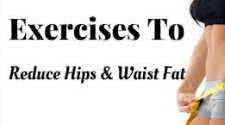Waist Reduction Exercises for Men & Women - Best Way to Reduce Size

Attaining the Perfect Wasp Like Waist is The Goal
The abdominal wall on each side of the trunk is made up of a triple layer of muscles. The outer visible layer is the external oblique; beneath that is the internal oblique; and the innermost layer
is the transverse muscle. As with any muscle group, the sidewall of your abdomen will grow in size if you exercise the sidewall directly, especially when using a weight. As you have already discovered,
performing side bends with a heavy dumbbell will beef out the obliques and thereby increase your waist size. Heavy squats and deadlifts have a tendency to do this as well.
When your bodyfat is low a toned set of oblique muscles provides a picturesque frame to a muscular, abdominal six-pack. But if you overdevelop the obliques the trunk takes on a thicker appearance. As
the waist gets wider that athletic V-taper is lost. Chunky obliques will have different aesthetic consequences, depending on your genetic build. In bodybuilders with a narrow waist the obliques can be
built up with little visible effect on the V-taper. However, in those bodybuilders with hips and waist that are genetically wider, even a small size increase in the obliques can dramatically offset the
chest-to-waist size differential - giving the appearance of a blocky waist and narrow shoulders.
The simple solution to overdeveloped obliques is to quit doing any exercises that directly work them. Any muscle will get smaller if you stop training it. Once your obliques have shrunk to an acceptable
size you can still exercise them. Whatever exercises you choose - twisting sit ups, leg raises or side bends -perform higher reps using only body-weight as resistance. Do not add weight. Monitoring your
progress over time you '11 discover what exercises work best for you. If you 're still having trouble with that blocky-belly look despite modifying your waist routine with bodyweight-only exercises, you
might want to consider eliminating heavy squats and deadlifts from your overall weight-training program.